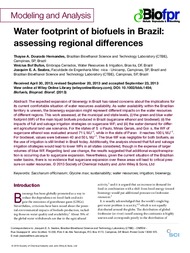Water footprint of biofuels in Brazil: assessing regional differences.
Water footprint of biofuels in Brazil: assessing regional differences.
Author(s): HERNANDES, T. A. D.; BUFON, V. B.; SEABRA, J. E. A.
Summary: The expected expansion of bioenergy in Brazil has raised concerns about the implications for its current comfortable situation of water resources availability. As water availability within the Brazilian territory is uneven, the bioenergy expansion might represent different impacts on the water resources of different regions. This work assessed, at the municipal and state levels, (i) the green and blue water footprint (WF) of the main liquid biofuels produced in Brazil (sugarcane ethanol and biodiesel); (ii) the impacts of full and salvage irrigation strategies on sugarcane WF; and (iii) the water demand for different agricultural land use scenarios. For the states of São Paulo, Minas Gerais, and Goiás, the WF of sugarcane ethanol was evaluated around 71 L MJ?1, while in the state of Paraná it reaches 100 L MJ?1. For biodiesel, values were between 40 and 50 L MJ?1. The blue WF was negligible for both biofuels, as the use of irrigation is still limited in Brazil today. Additionally, the analysis showed that full and salvage irrigation strategies would lead to lower WFs in all states considered, though in the expense of larger volumes of blue WF. Regarding land use change, the results suggested that additional evapotranspiration is occurring due to sugarcane expansion. Nevertheless, given the current situation of the Brazilian water basins, there is no evidence that sugarcane expansion over these areas will lead to critical pressure on water resources.
Publication year: 2013
Types of publication: Journal article
Unit: Embrapa Cerrados
Observation
Some of Embrapa's publications are published as ePub files. To read them, use or download one of the following free software options to your computer or mobile device. Android: Google Play Books; IOS: iBooks; Windows and Linux: Calibre.
Access other publications
Access the Agricultural Research Database (BDPA) to consult Embrapa's full library collection and records.
Visit Embrapa Bookstore to purchase books and other publications sold by Embrapa.

